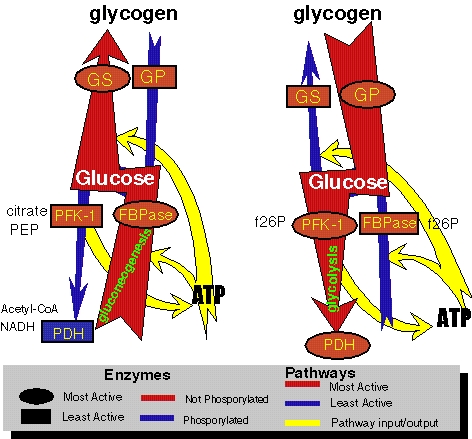

An overall view of glucose metabolism has glucose itself as a branch point. It can either be stored as glycogen (mostly in the liver and some in muscle cells) OR it can degraded and its energy converted to ATP. There are four pathways for this.
Each of these pathways has an enzyme that is primarily reposnsible for determining the the rate of the entire pathway (Glycolysis and gluconeogenesis have other regulation points as well, but these are the ones that we are primarily interested in for the purpoes of this course)
| Pathway | Enzyme |
| Glycogen Synthesis | Glycogen Synthase (UDP-glucose → glycogen polymer) |
| Glycogen Breakdown | Glycogen Phsophorylase (glycogen polymer → glucose-1-P) |
| Glycolysis | Phosphofructokinase-1 (F6P + ATP → F16BP + ADP) |
| Gluconeogenesis | Fructosebisphosphatase (F16BP → F6P + PO4=) |
Each of these four enzymes are regulated via allosteric bonding interactions. Some compounds are common to all four.
Compounds that bind to the allosteric sites of the following enzymes
| When the Compound | Binds to the Allosteric Site of: | Stabilizing the | Having the Effect of |
| ATP | Glycogen synthase | GOOD (R) | Increases glocose storage as glycogen |
| Glycogen Phosphorylase | POOR (T) | ||
| Phosphofructokinase-1 | POOR (T) | Decreases glucose energy conversion to ATP | |
| Fructose 1,6 Bisphosphatase | GOOD (R) | ||
| ADP/AMP | Glycogen synthase | POOR (T) | Decreases glucose storage as glycogen |
| Glycogen Phosphorylase | GOOD (R) | ||
| Phosphofructokinase-1 | GOOD (R) | Increases energy conversion to ATP | |
| Fructose 1,6 Bisphosphatase | POOR (T) | ||
| In Liver cells Fructose 2,6 Bisphosphate | Glycogen synthase | does not bind | No Effect |
| Glycogen Phosphorylase | does not bind | ||
| Phosphofructokinase-1 | GOOD (R) | Increases energy conversion to ATP | |
| Fructose 1,6 Bisphosphatase | POOR (T) | ||
| High ATP Concentration | Low ATP Concentration |
 | |
| When ATP concetration is high, there is little need to make more ATP. Instead the available energy is used to synthesize glucose (in liver cells at least) and store the glucose as glycogen | When ATP concetrations are relatively low then the entire system "inverts" and glucose is taken out of storage and taken through glycolysis to generate more ATP. |
The ovals and rectangles represent the regulated enzymes. Ovals being most active and retangles being least active. The thick red arrow represents the pathways that are most "active" while the thin blue arrows represent the least active pathways. The yellow arrows are thre just to remind you that it takes ATP input to make glucose and glycogen, while ATP synthesis from glycolysis. The abbreviations are:
| |
Compounds OTHER THAN ATP/AMP that have an allosteric effect on enzyme activities are listed near the form of the enzyme that they bind to preferentially. eg citrate induces the POOR catalytic form of PFK-1 and is listed near the Least Active form of the enzyme.
For cells that store Glycogen as well as consume glucose (Liver and Muscle cells), the system responds to changes in [ATP] within the cell as pictured above. In times of low demand the [ATP] is high relative to the [AMP]---- gluconeogenesis and Glycogen synthesis are favored by making PFK-1 and GP less active while increasing the activity of GS and FBPase through allosteric mechanisms.
In times of high ATP demand it's concentration drops relative to [AMP] ---- Glycogen breakdown and glycolysis are favored by allosteric mechanisms. The effects are the opposite of that mentioned above. PDH is also more active by a specific Phosphorylase the hydrolyzes phosphate.